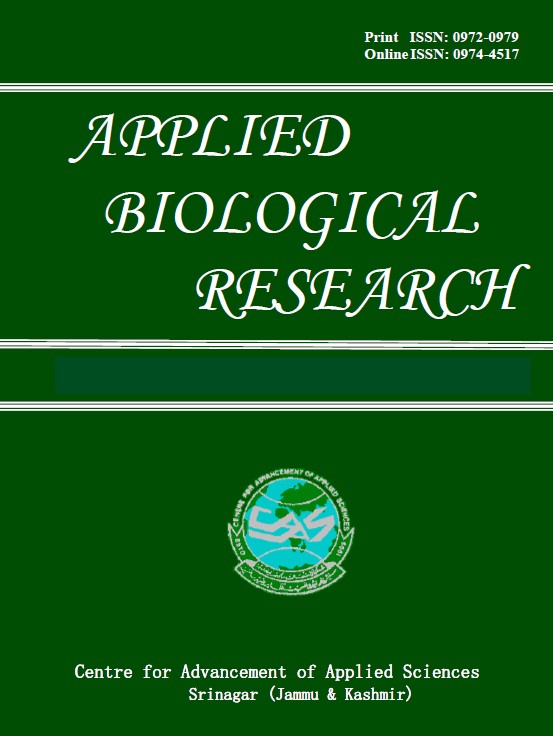CHARACTERISTICS AND SOME APPLICATIONS OF MODIFIED XSHANKER DISTRIBUTION
DOI:
https://doi.org/10.48165/abr.2025.27.01.10Keywords:
Double XShanker distribution, maximum likelihood estimation, probability, reliability measures, weighted distributionAbstract
The selection of a suitable distribution for many bio-medical real data analysis is a tedious task. The general known distributions are not a good-fit, in such cases, researchers are trying for innovative distributions to overcome such situations. Since many such real data are non-symmetric, hence they do not follow normality. In this paper, we have developed a novel version of double XShanker distribution termed as 'Modified XShanker Distribution (MOXD)' which has been described by using the weighted technique. This particular new distribution has been illustrated and explored with different statistical properties and its parameters are estimated on the basis of maximum likelihood estimation. To illustrate the predictability and flexibility of new distribution, we introduced a real lifetime biomedical data set to newly developed distribution to determine its performance over other comparable well-known distributions. Two independent real-world datasets were examined. The first dataset involved the birth weights of 130 randomly chosen new-borns from a hospital in Chennai (India). The second dataset pertained to triglyceride levels, focusing on the mean reduction (mg dL⁻¹) in triglycerides observed in 177 randomly selected patients from another Chennai hospital. These patients were monitored after taking Atorvastatin (Atorvaliq, Lipitor) continuously for 3 weeks, with triglyceride levels measured using the Cholesterol-oxidase method.Downloads
References
Ahmad, A. and Ahmad, S.P. (2014). Characterization and estimation of double weighted Rayleigh distribution. Journal of Agriculture and Life Sciences, 1(2): 21–28.
Ahmad, A. and Tripathi, R. (2021). Power size-biased Maxwell distribution with applications related to engineering data. International Journal of Statistics and Applied Mathematics, 6(6): 137–147.
Al-Omari, A.I. and Dobbah, S.A. (2023). On the mixture of Shanker and gamma distributions with applications to engineering data. Journal of Radiation Research and Applied Sciences, 16(1): 100533.
Etaga, H.O., Nwankwo, M.P., Oramulu, D.O. and Obulezi, O.J. (2023). An improved XShanker distribution with applications to rainfall and vinyl chloride data. Scholars Journal of Engineering and Technology, 11(9): 212–224.
Fisher, R.A. (1934). The effect of methods of ascertainment upon the estimation of frequencies. Annals of Eugenics, 6(1): 13–25.
Hassan, A., Dar, A. and Para, B. (2019). A new generalization of Ishita distribution: Properties and applications. Journal of Applied Probability and Statistics, 14(2): 53–67.
Hassan, A., Wani, S.A., Ahmad, S.B. and Akhtar, N. (2020). A new generalized quasi Xgamma distribution applicable to survival times. Journal of Xi’an University of Architecture & Technology, 12(4): 3720–3736.
Hinou, H. (2024). Triglycerides: its functions, health implications and their significance in maintaining optimal levels. Journal of Glycomics and Lipidomics, 13: 361. [https://doi.org/10.35248/2153-0637.24.13.361].
Kumar, M.S. and Subramanian, C. (2019). A new extension of Devya distribution with properties and applications in real life data. Journal of Information and Computational Science, 9(11): 1188–1201.
Ray, M. and Shanker, R. (2023). A of exponential and Shanker distribution with an application. Journal of Scientific Research of the Banaras Hindu University, 67(4): 39–46.
Radhakrishna Rao, C. (1985). Weighted distributions arising out of methods of ascertainment: What population does a sample represent? In: Springer eBooks, Springer Nature, pp. 543–569. [https://doi.org/10.1007/978-1-4613-8560-8_24].
Shanker, R. (2015). Shanker distribution and its applications. International Journal of Statistics and Applications, 5(6): 338–348.
Ganaie, R.A. and Rajagopalan, V. (2023). The weighted power quasi Lindley distribution with properties and applications of lifetime data. Pakistan Journal of Statistics and Operation Research, 19(2): 279–298.
Sarma, S. and Das, K.K. (2021). Weighted inverse Nakagami distribution. Thailand Statistician, 19(4): 698–720.
Sofi, M. and Ahmad, S.P. (2017). Characterization and information measures of weighted Erlang distribution. Journal of Statistics Applications & Probability Letters, 4(3): 109–122.

